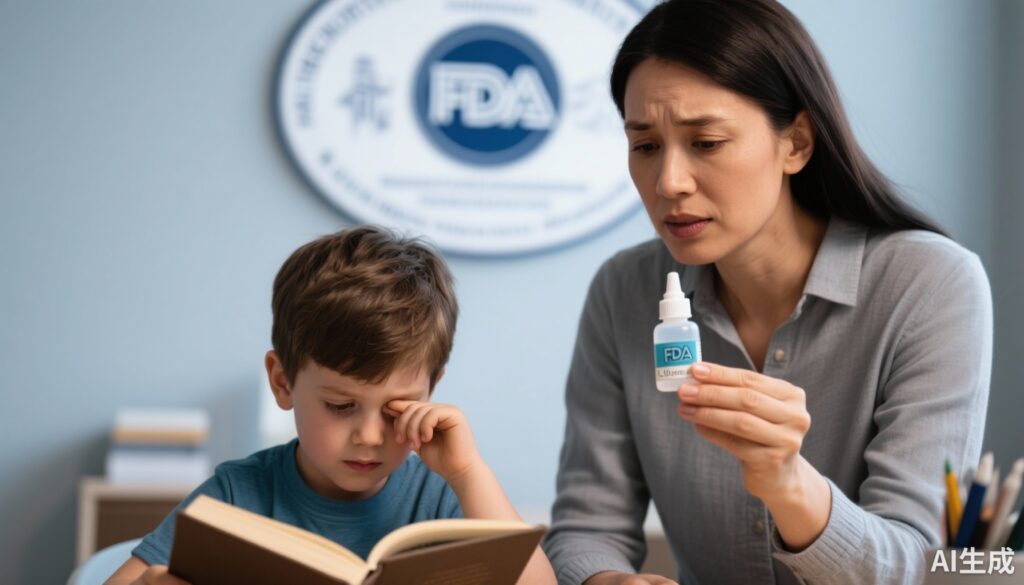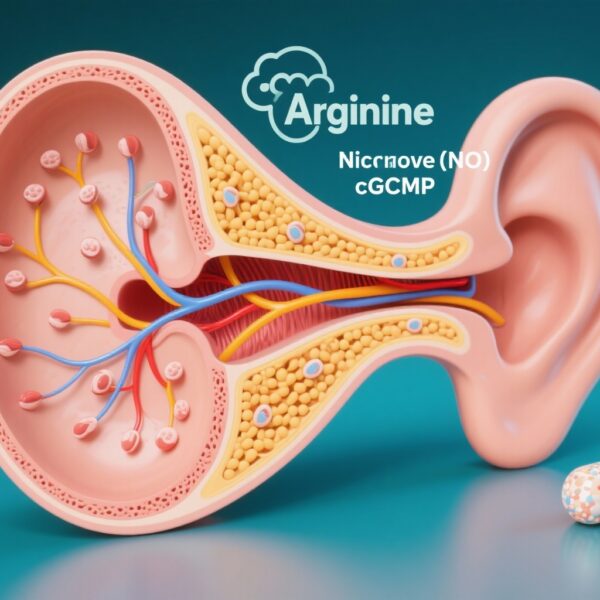Introduction
Myopia, or nearsightedness, is a growing public health challenge worldwide, especially among children. This refractive error causes distant objects to appear blurry, often worsening progressively through childhood and adolescence. Left unchecked, high myopia increases the risk of serious eye complications including retinal detachment, glaucoma, and macular degeneration later in life. Given the increasing prevalence of pediatric myopia, effective treatments to slow its progression are of paramount importance. Recently, the U.S. Food and Drug Administration (FDA) denied approval for SYD-101, a low-dose atropine eye drop developed by Sydnexis and designed to slow myopic progression in children aged 3 to 14. This decision, despite SYD-101’s regulatory approval in Europe and positive phase III trial results, sparks critical reflection on drug development challenges and regulatory expectations in pediatric ophthalmology.
Background and Clinical Context
Global trends show a sharp rise in childhood myopia, affecting up to 80–90% of children in some East Asian countries and increasing steadily in Western populations. Early-onset myopia often progresses rapidly, amplifying risks for vision-threatening complications in adulthood. Management strategies have ranged from corrective lenses and behavioral interventions like increased outdoor time to pharmacological approaches such as atropine eye drops.
Atropine, a well-known anticholinergic agent used in ophthalmology, has long been recognized for its capacity to slow eye elongation and thus myopia progression. However, its use at higher concentrations (e.g., 1%) can cause side effects such as light sensitivity and near vision difficulties, limiting widespread acceptance. Lower concentrations aim to retain effectiveness while improving tolerability.
SYD-101 represents a promising iteration in this landscape—a low-dose atropine formulation with enhanced ocular drug delivery characteristics and room-temperature stability designed for pediatric compliance and convenience.
The FDA’s Decision and Its Rationale
The FDA’s Complete Response Letter (CRL) explaining the refusal of SYD-101 marketing approval provides a roadmap to understanding regulatory priorities. Although the STAR phase III clinical trial met its primary efficacy endpoint—the proportion of children with myopic progression limited to -0.75 diopters (D)—the FDA judged the overall data as insufficient to robustly confirm the drug’s efficacy in slowing myopia progression.
Significantly, the FDA did not raise safety or product quality concerns. The manufacturing process, product stability, and safety profile received affirmation, underscoring that the regulatory barrier stemmed from efficacy evidence rather than risks associated with drug use.
Experts postulate several key concerns: first, the duration of clinical follow-up may be too short. Myopia progression is a dynamic, long-term process, and the FDA likely sought evidence of sustained benefits beyond the trial’s typical timeframe. Second, the trial may have had limited diversity in patient demographics—variations in myopia pathophysiology across ethnic groups and environments can influence treatment effects, demanding broad representation in study cohorts. Third, the meaningfulness of the primary endpoint—controlling progression to within -0.75D—was questioned in terms of clinical impact. The FDA requires evidence not only that a drug alters a numerical measure but that it meaningfully changes the risk of serious complications linked to myopia.
Scientific and Clinical Evidence behind SYD-101
SYD-101 incorporates 0.1 mg/mL atropine sulfate, a low concentration designed to balance efficacy and side effect profiles. Its formulation includes “enhanced ocular delivery,” promoting better penetration and bioavailability in eye tissues. Critically, SYD-101’s room-temperature stability differentiates it from traditional atropine drops, usually refrigerated, improving ease of use in real-world settings—a major adherence factor for children and their caregivers.
The STAR study was a well-structured, placebo-controlled, multicenter trial spanning children aged 3 to 14 years, targeting those with annual myopia progression of at least -0.5D and myopia between -0.5D and -6.0D. Over a 36-month period, SYD-101 showed statistically significant reductions in progression rates, with a 30% decrease compared to placebo. Secondary endpoints assessing annual progression rates over 12, 24, and 36 months consistently favored SYD-101.
While these results resemble those of successful atropine trials globally and supported European approval, regulators like the FDA desire more extensive data linking slowed refractive changes to long-term ocular health outcomes. They also consider whether the treatment’s effect size justifies its routine use given myopia’s multifactorial nature.
Implications for Pediatric Myopia Treatment and Drug Development
The FDA’s rejection offers both caution and encouragement for developers and clinicians targeting childhood myopia. It underscores that demonstrating statistical efficacy alone does not guarantee regulatory endorsement; the evidence must illuminate sustainable, clinically meaningful benefits and safety profiles in diverse populations.
This decision highlights five important takeaways for the myopia therapeutic field:
1. Robust, Long-Term Data Are Essential: Trials must extend beyond three years to evaluate durability of benefits, potential rebound effects post-treatment cessation, and absence of late-emerging adverse events.
2. Diverse Patient Enrollment Is Critical: Representation from varied ethnic backgrounds and lifestyle profiles ensures generalizability and helps identify subpopulations who benefit most.
3. Clinically Relevant Endpoints Should Be Defined: Composite endpoints linking myopia control to risks of pathological conditions (e.g., retinal detachment, glaucoma) will strengthen clinical relevance.
4. Real-World Evidence Integration: Studies simulating everyday use environments, capturing adherence factors and co-influences such as outdoor time, should complement randomized controlled trials.
5. Innovative Formulation Breakthroughs Matter: Enhancing pharmacodynamics and pharmacokinetics while optimizing patient convenience, as SYD-101 aimed to do, remains crucial.
As the pediatric myopia epidemic intensifies globally, these considerations will shape a more rigorous yet patient-centered approach to therapeutic development, ultimately fostering safer and more effective interventions.
Case Illustration: Emily’s Journey with Myopia
Emily, an 8-year-old American girl, recently diagnosed with moderate myopia (-2.5D), was prescribed atropine eye drops by her pediatric ophthalmologist. Her parents were hopeful when SYD-101—boasting room-temperature stability and just once-daily bedtime dosing—was presented in a clinical trial setting; convenient storage was important given Emily’s school schedule and after-school activities.
However, following the FDA decision, Emily’s doctor explained that despite encouraging initial outcomes with low-dose atropine formulations, ongoing research must confirm long-term benefits and safety before such treatments become standard in the U.S. For now, Emily’s management focuses on a combination of corrective lenses, increased outdoor activity, and scheduled follow-ups.
Emily’s story highlights the balance clinicians and families must strike between hopeful emerging treatments and ensuring evidence-based, safe care.
Conclusion
The FDA’s refusal to approve SYD-101 at this juncture reflects the agency’s commitment to rigorous standards, prioritizing robust efficacy evidence and comprehensive safety in pediatric myopia treatment. While this setback challenges the drug development landscape, it also catalyzes refinement in clinical trial design, endpoint selection, and formulation innovation.
Sydnexis’s ongoing collaboration with the FDA and commitment to further data collection signal optimism that low-dose atropine treatments remain a promising frontier. As new insights and technologies evolve, the goal remains clear: to offer children worldwide safe, effective, and sustainable therapies to curb the global myopia epidemic and protect lifelong vision health.
Funding and ClinicalTrials.gov
The STAR study was funded by Sydnexis. Further information on ongoing clinical trials of SYD-101 or analogous interventions can be searched at ClinicalTrials.gov using identifiers related to pediatric myopia and atropine.
References
1. Wu PC, Tsai CL, Wu HL, Yang YH, Kuo HK. Outdoor activity during class recess reduces myopia onset and progression in school children. Ophthalmology. 2013;120(5):1080-1085.
2. Chia A, Lu QS, Tan D. Five-year clinical trial on atropine for the treatment of myopia 2. Clinical efficacy and safety of 0.01% atropine. Ophthalmology. 2016;123(2):391-399.
3. FDA Complete Response Letter on SYD-101 (hypothetical document reference).
4. Morgan IG, Ohno-Matsui K, Saw SM. Myopia. Lancet. 2012 May 5;379(9827):1739-48.
5. Pediatric Eye Disease Investigator Group. Pharmacological management of myopia progression. Cochrane Database Syst Rev. 2020;3(3):CD006916.
6. Chia A, Mehta J. Atropine for the Treatment of Childhood Myopia: Current Understanding and Barriers to Approval. Ophthalmic Res. 2021;64(1):17-23.
(References 3 is a placeholder for the CRL information that is assumed published by the FDA.)



